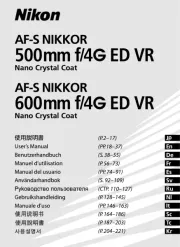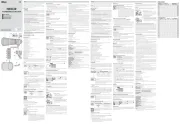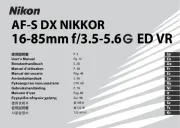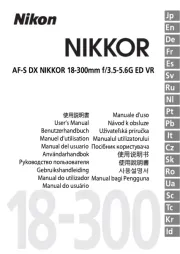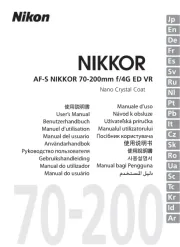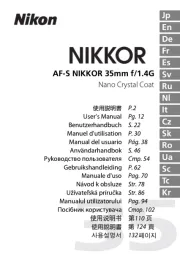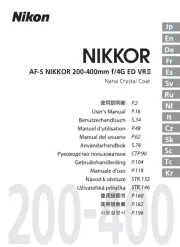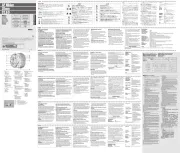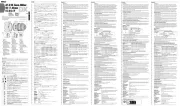
使用説明書の内容が破損などによって判読できなくなったときは、ニコンサービス機関にて新しい使用説明書をお求めください(有料)。
No reproduction in any form of this manual, in whole or in part (except for brief
quotation in critical articles or reviews), may be made without written authorization
52mm snap-on front lens cap
Bouchon avant d'objectif diamètre 52 mm
Aufsteckbarer Frontdeckel 52mmφ
Tapa frontal a presión de 52 mm
Tappo anteriore da 52mm dia.
Printed in Japan TT6D24 (80)
ニコンのAF[オートフォーカス(レンズマウントにAFカップ
リングがないカメラ、F3AFを除く)]カメラとの組み合わせ
でオートフォーカス撮影ができます。また、マニュアル(手動)
によるピント合わせも可能です。さらに撮影距離情報を取り入
れたカメラとの組み合わせでは、撮影距離情報をカメラに伝達
する機能を備えています。広角レンズですので風景写真はもと
より、建築写真や狭い室内での撮影、スナップ、旅行の際の記
録写真など幅広い用途に適しています。また、遠近感が極端に
誇張されますので、特異な効果を狙った迫力のある写真が得ら
れ、近距離補正方式により近写性能も優れています。
上記以外のアクセサリーにつきましても、カメラとの組み合わせに
よりご使用できないことがあります。アクセサリーのご使用に際し
ては、必ず各カメラの使用説明書も併せてご参照ください。
レンズ表面の汚れや傷を防ぐために、NCフィルターの使用をおす
すめします。レンズの保護には、フードも役立ちますのでご使用
約64.5(最大径)×46mm(長さ:バヨネットマウン
•Autofokusbetrieb mit entsprechend ausgerüsteten Nikon-
Autofokuskameras (außer F3AF und Kameras, die kein
Bajonett mit AF-Anschlussstück haben); manuelle
Schärfeneinstellung mit allen Nikon-Spiegelreflexkameras.
•L’autofocus est possible avec un boîtier autofocus Nikon
(sauf F3AF et les appareils photo à monture d'objectif sans
couplage AF), la mise au point manuelle avec tous les
•Es posible un funcionamiento con enfoque automático en las
cámaras de enfoque automático de Nikon (excepto F3AF y las
cámaras con monturas del objetivo sin acoplamiento AF);
aunque es posible el enfoque manual con todas las SLR de
●仕様、外観の一部を、改善のため予告なく変更することがあ
Änderungen von technischen Daten und Design durch den Hersteller
vorbehalten.
Les caractéristiques et le dessin sont susceptibles d’être modifiés sans préavis
ni obligation de la part du constructeur.
Las especificaciones y los diseños están sujetos a cambio sin previo aviso ni
obligación por parte del fabricante.
ニコンF6、F5、F4、F3シリーズカメラには多種類のファイン
ダースクリーンが用意されています。レンズのタイプや撮影条件に
合わせて、最適なものを選ぶことができます。このレンズに適した
(なお、ご使用に際しては必ず各カメラの使用説明書を併せてご参
d’ustilisation de l’apparell spécifique.
del usuario de la cámara de que se trate.
Für Nikon Kameras der Serien F6, F5, Serien F4 und
Serien F3 stehen verschiedene auswechselbare
Einstellscheiben zur Verfügung, um jedem Objectiv und
jeder Aufnahmesituation gerecht zu werden. Die für
dieses Objectiv empfohlenen werden in der Tabelle
aufgeführt (siehe Rückseite). Weitere Einzelheiten siehe
auch Benutzerhandbuch der Kamere.
ca. 64,5mm Durchmesser. x 46mm
Thank you for purchasing the AF Nikkor 24mm
f/2.8D lens. Object distance infor
be transferred to the camera body when the
lens is used with any Nikon model with 3D
Matrix Metering capability.
Autofocus operation is possible with Nikon autofocus cameras
(except the F3AF and cameras with lens mounts that do not
have AF coupling); manual focus possible with all Nikon SLRs.
•Do not attach the following accessories to the lens, as they
might damage the lens CPU contacts: Auto Extension Ring
PK-1, PK-11 (use PK-11A), K1 Ring, Auto Ring BR-4, Auto
Ring BR-2 (use BR-2A) and K2 Ring.
•This lens cannot be used with the AF Finder DX-1 attached
to the Nikon F3AF camera.
Minimum aperture lock lever (Fig. A)
For programmed auto or shutter-priority auto shooting, use the
minimum aperture lock lever to lock the lens aperture at f/22.
1.Set the lens to its minimum aperture (f/22).
2.Slide the lock lever in the direction of the aperture ring so
that white dot on the tab aligns with the orange dot.
To release the lock, slide the lever in the reverse direction.
Recommended Focusing Screens
Various interchangeable focusing screens are available for
Nikon F6, F5, F4- and F3-series cameras to suit any type of
lens or picture-taking situation. Those which are
recommended for use with this lens are listed in the table
(See the reverse). For details, also refer to the specific
•Clean lens surface with a blower brush. To remove dirt
and smudges, use a soft, clean cotton cloth or lens tissue
moistened with ethanol (alcohol) or lens cleaner. Wipe in
a circular motion from center to outer edge, taking care
not to leave traces and not to touch the other lens parts.
•Never use thinner or benzine to clean the lens.
•To protect the lens surface from dirt or damage, the use
of an NC filter is recommended at all times. The lens
hood also helps to protect the lens.
•Attach both the front and rear lens caps when lens is not
•Do not splash water on the lens or drop it in the water
because this will cause it to rust and malfunction.
•When not using the lens for a long time, store it in a cool,
dry place to prevent mold from growing. Also store the
lens away from direct sunlight or chemicals such as
•Reinforced plastic is used for some parts in the lens unit;
to avoid damage, take extra care to never leave the lens in
an excessively hot place.
52mm screw-in lens hood HN-1
Flexible lens pouch CL-0715
Lens construction : 9 elements in 9 groups
Distance scale : Graduated in meters and feet from 0.3m
(1.25ft) to infinity ( ).∞
Distance information: Output of object distance information to
the camera body is possible.
Aperture scale : f/2.8 to f/22 on both standard and
aperture-direct-readout scales
Diaphragm : Fully automatic
Via full-aperture method for AI cameras
or cameras with CPU interface system;
via stop-down method for other cameras
Mount : Nikon bayonet mount
Attachment size : 52mm (P=0.75mm)
Approx. 64.5mm dia. x 46mm (extension
from the camera’s lens mounting flange);
overall length is approx. 55.5mm
Weight : Approx. 270g (9.5 oz)
Specifications and designs are subject to change without
any notice or obligation on the part of the manufacturer.
Aperture scale index (white dot)
Aperture-direct-readout scale
Minimum aperture lock lever
Infrared compensation index (white dot)
Depth-of-field indicators
Fig A Minimum aperture lock lever
•Il funzionamento con messa a fuoco automatica è possibile
con le fotocamere autofocus Nikon (tranne la F3AF e le
fotocamere con innesti dell’obiettivo senza accoppiamento
AF); la messa a fuoco manuale è possibile con tutte le reflex
Vari schermi di messa a fuoco sono disponibili per l’uso con le
fotocamere delle Nikon F6, F5, serie F4, e serie F3 adatti a
qualsiasi tipo di obiettivo o situazione. Quelli raccomandati per
questo obiettivo sono elencati nella lista (Vedere sul retro). Per
maggiori dettagli, consultate il manuale d’uso della fotocamere.
Le specifiche e i disegni sono soggetti a modifica senza preavviso o obblighi
da parte del produttore.
Env. 64.5mm diam. x 46mm (rallonge
de la bride de montage d’objectif de
l’appareil); longueur hors-tout est env.
Aprox. 64,5mm de diám. x 46mm (de
extensión desde la pestaña de
montaje del objetivo existente en la
cámara); la longitud total es de
Ca. 64,5mm diam. x 46mm (di estensione
dalla flangia di installazione dell’obiettivo della
telecamere); lunghezza totale ca. 55,5mm
△記号は、注意(警告を含む)を促す内容を告げるものです。図の中や近くに具体的な注意内容(左図の場合は感電注
記号は、禁止の行為(してはいけないこと)を告げるものです。図の中や近くに具体的な禁止内容(左図の場合は分解
●記号は、行為を強制すること(必ずすること)を告げるものです。図の中や近くに具体的な強制内容(左図の場合は
この表示を無視して、誤った取り扱いをすると、人が死亡または重傷を負う可能性が想定される内容を示しています。
この表示を無視して、誤った取り扱いをすると、人が傷害を負う可能性が想定される内容および物的損害の発生
ご使用の前に「安全上のご注意」をよくお読みのうえ、正しくお使いください。この「安全上のご注意」は製品を安全に正しく使
用していただき、あなたや他の人々への危害や財産への損害を未然に防止するために、重要な内容を記載しています。お読みにな
った後は、お使いになる方がいつでも見られる所に必ず保管してください。
太陽光がカメラ内部で焦点を結び、火災の原因になることがあります。画角から太陽をわずかに外しても火災
使用しないときは、レンズにキャップをつけるか太陽光のあたらない所に保管すること
太陽光が焦点を結び、火災の原因になることがあります。
三脚にカメラやレンズを取り付けたまま移動しないこと
転倒したりぶつけたりしてケガの原因になることがあります。
窓を閉め切った自動車の中や直射日光が当たる場所など、異常に温度が高くなる場所に放置し
内部の部品に悪い影響を与え、火災の原因となることがあります。
お守りいただく内容の種類を、次の絵表示で区分し、説明しています。
落下などによって破損し、内部が露出したときは、露出部に手を触れないこと
感電したり、破損部でケガをする原因となります。カメラの電池を抜いて、販売店またはニコンサービス
熱くなる、煙が出る、こげ臭いなどの異常時は、速やかにカメラの電池を取り出すこと
そのまま使用すると火災、やけどの原因となります。電池を取り出す際、やけどに充分注意してください。電
池を抜いて、販売店またはニコンサービス機関に修理を依頼してください。
水につけたり、水をかけたり、雨にぬらしたりしないこと
プロパンガス・ガソリンなど引火性ガスや粉塵の発生する場所で使用すると、爆発や火災の原因となります。
Notes on Safety Operations
Touching the internal parts of the camera or lens could
result in injury. Repairs should be performed only by
qualified technicians. Should the camera or lens break
open as the result of a fall or other accident, take the
product to a Nikon-authorized service representative for
inspection after unplugging the product and/or
Turn off immediately in the event of malfunction
Should you notice smoke or an unusual smell coming
from the camera or lens, remove the battery
immediately, taking care to avoid burns. Continued
operation could result in injury.
After removing or disconnecting the power source, take
the product to a Nikon-authorized service representative
Do not use the camera or lens in the presence of
Operating electronic equipment in the presence of
flammable gas could result in an explosion or fire.
Do not look at the sun through the lens or
Viewing the sun or other strong light sources through
the lens or viewfinder could cause permanent visual
Keep out of reach of children
Particular care should be taken to prevent infants from
putting the batteries or other small parts into their mouths.
Observe the following precautions when handling
• Keep the camera and lens unit dry. Failure to do so
could result in fire or electric shock.
Do not handle or touch the camera or lens unit with wet
hands. Failure to do so could result in electric shock.
• When shooting with back-lighting, do not point the
lens at the sun or allow sunlight to pass directly down
the lens as this may cause the camera to overheat and
• When the lens will not be used for an extended period
of time, attach both front and rear lens caps and store
the lens away from direct sunlight. Failure to do so
could result in a fire, as the lens may focus sunlight
Hinweise für sicheren Betrieb
Beim Berühren der Innenteile von Kamera oder
Objektiv droht Verletzungsgefahr. Überlassen Sie
Reparaturen unbedingt ausschließlich qualifizierten
Technikern. Kommt es durch einen heftigen Stoß
(z.B. Fall auf den Boden) zu einem Bruch von
Kamera oder Objektiv, so trennen Sie zunächst das
Produkt vom Stromnetz bzw. entnehmen die
Batterie(n) und geben es dann an eine autorisierte
Nikon-Servicestelle zur Überprüfung ab.
Bei einer Störung sofort die Stromversorgung
Bei Entwicklung von Rauch oder ungewöhnlichem
Geruch durch Kamera oder Objektiv entnehmen Sie
sofort die Batterie(n); dabei vorsichtig vorgehen,
denn es besteht Verbrennungsgefahr. Bei einem
Weiterbetrieb unter diesen Umständen droht
Nach dem Abtrennen von der Stromversorgung
geben Sie das Gerät an eine autorisierte Nikon-
Servicestelle zur Überprüfung ab.
Kamera oder Objektiv keinesfalls bei
Vorhandensein von brennbarem Gas einsetzen.
Wird elektronisches Gerät bei brennbarem Gas
betrieben, so droht u.U. Explosions- oder
Keinesfalls durch Objektiv oder Sucher in die
Beim Betrachten der Sonne oder anderer starker
Lichtquellen durch Objektiv oder Sucher droht eine
permanente Schädigung des Sehvermögens.
Dem Zugriff von Kindern entziehen.
Es ist unbedingt dafür zu sorgen, dass Kleinkinder
keine Batterien oder andere Kleinteile in den Mund
Beim Umgang mit Kamera und Objektiv unbedingt die
folgenden Vorsichtmaßnahmen beachten:
Schützen Sie die Kamera und das Objektiv vor
Feuchtigkeit. Andernfalls droht Brand- oder
• Handhaben oder berühren Sie die Kamera bzw. das
Objektiv keinesfalls mit nassen Händen. Andernfalls
• Bei Gegenlichtaufnahmen nicht das Objektiv gegen die
Sonne richten oder das Sonnenlicht direkt durch das
Objektiv eintreten lassen. Dies könnte eine Überhitzung
der Kamera verursachen und ein Brand könnte die
• Vor einem längeren Nichtgebrauch des Objektivs
bringen Sie den vorderen und hinteren Deckel an und
bewahren das Objektiv geschützt vor direkter
Sonnenlichteinwirkung auf. Andernfalls droht
Brandgefahr wegen möglicher Fokussierung von
Sonnenlicht durch das Objektiv auf brennbare
Remarques concernant une utilisation
Le fait de toucher aux pièces internes de l’appareil ou
de l’objectif pourrait entraîner des blessures. Les
réparations doivent être effectuées par des techniciens
qualifiés. Si l’appareil ou l’objectif est cassé suite à une
chute ou un autre accident, apportez le produit dans un
centre de service agréé Nikon pour le faire vérifier
après avoir débranché le produit et retiré les piles.
En cas de dysfonctionnement, éteignez l’appareil
Si vous remarquez de la fumée ou une odeur
inhabituelle se dégageant de l’appareil photo ou de
l’objectif, retirez immédiatement les piles, en prenant
soin de ne pas vous brûler. Continuer d’utiliser son
matériel peut entraîner des blessures. Après avoir retiré
ou débranché la source d’alimentation, confiez le
produit à un centre de service agréé Nikon pour le faire
N’utilisez pas l’appareil photo ou l’objectif en
présence de gaz inflammable
L’utilisation de matériel électronique en présence de
gaz inflammable risquerait de provoquer une explosion
Ne regardez pas le soleil dans l’objectif ou le
Regarder le soleil ou toute autre source lumineuse
violente dans l’objectif ou le viseur peut provoquer de
graves lésions oculaires irréversibles.
Tenir hors de portée des enfants
Faites extrêmement attention à ce que les enfants ne
mettent pas à la bouche les piles ou d’autres petites
Observez les précautions suivantes lorsque vous
manipulez l’appareil et l’objectif
• Maintenez l’appareil photo et l’objectif au sec. Le
nonrespect de cette précaution peut provoquer un
incendie ou une électrocution.
• Ne manipulez pas et ne touchez pas l’appareil photo
ou l’objectif avec les mains humides. Le non-respect
de cette précaution peut provoquer une électrocution.
• Lors d’une prise de vue à contre-jour, ne dirigez pas
l’objectif vers le soleil et évitez que les rayons du soleil
pénètrent dans l’objectif ; l’appareil photo pourrait
chauffer à l’excès, ce qui risquerait de provoquer un
• Lorsque vous n’utilisez pas l’objectif pendant une période
prolongée, fixez les bouchons avant et arrière, et rangez
l’objectif à l’abri de la lumière directe du soleil. Le non-
respect de cette précaution peut provoquer un incendie,
car l’objectif peut concentrer la lumière du soleil sur un
Notas sobre un uso seguro
El contacto con las piezas internas de la cámara o del
objetivo puede provocar lesiones. Las reparaciones
solamente deben ser ejecutadas por técnicos
cualificados. Si a causa de un golpe u otro tipo de
accidente la cámara o el objetivo se rompen y quedan
abiertos, desenchufe el producto y/o retire la batería, y
a continuación lleve el producto a un centro de servicio
técnico autorizado Nikon para su revisión.
Apague inmediatamente el equipo en caso de
funcionamiento defectuoso
Si observa que sale humo o que la cámara o el objetivo
desprenden un olor extraño, retire la batería
inmediatamente, con cuidado de no quemarse. Si sigue
utilizando el equipo corre el riesgo de sufrir lesiones.
Una vez extraída o desconectada la fuente de
alimentación, lleve el producto a un centro de servicio
técnico autorizado Nikon para su revisión.
No utilice la cámara ni el objetivo en presencia de
La utilización de equipos electrónicos en presencia de
gas inflamable podría producir una explosión o un
No mire hacia el sol a través del objetivo ni del
Mirar hacia el sol u otra fuente de luz potente a través
del objetivo o del visor podría producirle daños
Mantener fuera del alcance de los niños
Se debe tener especial cuidado en evitar que los niños
se metan en la boca pilas u otras piezas pequeñas.
Adopte las siguientes precauciones al manipular
• Mantenga la cámara y el objetivo secos. De no hacer
esto podría producirse un incendio o una descarga
• No manipule ni toque la cámara ni el objetivo con las
manos húmedas. De lo contrario podría recibir una
• En disparos a contraluz, no apunte el objetivo hacia el
sol ni deje que la luz solar pase directamente por él, ya
que podría sobrecalentar la cámara y, posiblemente,
• Cuando el objetivo no vaya a utilizarse por un período
de tiempo prolongado, colóquele la tapa frontal y
guárdelo alejado de la luz solar directa. De no hacer
esto podría producirse un incendio, p1-ya que el objetivo
podría enfocar la luz solar directa sobre un objeto
Note sulle operazioni di sicurezza
Toccando le parti interne della fotocamera o
dell’obiettivo si potrebbero causare dei guasti. Le
riparazioni devono essere eseguite solamente da
Qualora, in caso di caduta o di qualsiasi altro incidente,
la fotocamera o l’obiettivo dovessero rompersi, portare il
prodotto presso un punto di assistenza Nikon
autorizzato per l’ispezione, dopo averlo disinserito dalla
presa e/o rimosso la batteria.
In caso di malfunzionamento, disattivare
immediatamente la fotocamera
Qualora dalla fotocamera o dall’obiettivo dovesse uscire
del fumo o un odore insolito, rimuovere immediatamente
la batteria, facendo attenzione a non ustionarsi.
Continuando a utilizzare la fotocamera, sussiste il
Dopo aver rimosso o scollegato la fonte di
alimentazione, portare il prodotto presso un punto di
assistenza Nikon autorizzato per l’ispezione.
Non usare la fotocamera o l’obiettivo in presenza
L’utilizzo di apparecchiature elettroniche in presenza di
gas infiammabili può causare esplosioni o incendi.
Non guardare il sole in modo diretto attraverso
Guardando in modo diretto il sole o qualsiasi altra fonte
intensa di luce, si é soggetti al rischio di indebolimento
Tenere lontano dalla portata dei bambini
Fare molta attenzione che i bambini non ingeriscano le
batterie o altre piccole parti.
Nell’utilizzo della fotocamera e dell’obiettivo,
osservare le seguenti precauzioni
• Mantenere la fotocamera e l’obiettivo asciutti. In caso
contrario si potrebbe verificare un incendio o scosse
• Non maneggiare né toccare la fotocamera o l’obiettivo
con le mani bagnate. In caso contrario, si potrebbero
verificare scosse elettriche.
• Durante le riprese controluce, non puntare l’obiettivo
verso il sole ed evitare che la luce solare passi
direttamente attraverso di esso, poiché la fotocamera
potrebbe surriscaldarsi ed eventualmente provocare un
• Se si prevede di non utilizzare l’obiettivo per un
periodo prolungato di tempo, montare entrambi i tappi
di protezione e riporlo lontano dalla luce diretta del
sole. Il mancato rispetto di questa istruzione può
causare incendi, poiché l’obiettivo potrebbe
concentrare la luce del sole su un oggetto
